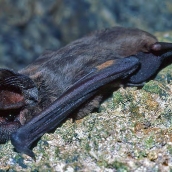European Free-tailed Bat (Tadarida teniotis)
A large bat with a forearm length of 54.7-69.9 mm. The ears are very wide, short and forward-pointing, and the tail extends almost half the length of the flight membrane. The muzzle is rather prominent and reminiscent of a bulldog. The fur is greyish-brown, although it can vary in colour, and the belly is paler. Distribution is widespread and comprises southern Europe, North Africa, the Middle East and Asia, stretching as far as India, south China and Indonesia. In Macaronesia it is only found in the Canaries (Gran Canaria, Tenerife, La Gomera, La Palma and El Hierro); the single sighting for Madeira is unreliable. Research carried out in Madeira by several authors in recent decades has had no positive results. The habitat of the European free-tailed bat includes coastal cliffs, deep ravines and inland peaks, from sea level up to 2,300 m, although it often hunts in towns and cities, attracted by public lighting. This bat dwells in rocky crevices and, to a lesser extent, cracks in large buildings or high bridges. Its flight is swift and at a great height, although it swoops close to the ground when hunting in lamp-lit streets; its call is a metallic ‘tic-tic’. It feeds mainly on nocturnal lepidoptera, for example, of the families Noctuidae and Sphingidae, and on the large specimens of Hyles tithymali. Its diet also includes dipterans, coleopterans and hymenopterans. Specific information on breeding is virtually non-existent and very little is known about the biology. In low- and mid-altitude areas of the islands, it is known to be active in late autumn and winter, but not so at higher altitudes (2,000 m), in the same period, which suggests hibernation or descent to lower areas. In the Canaries it is common and widespread, except in Gran Canaria, where it is highly localized and only a few specimens have been identified. However, it is negatively affected by pesticides and habitat alteration and loss. There are signs that populations have recovered or stabilized in the past few decades.













